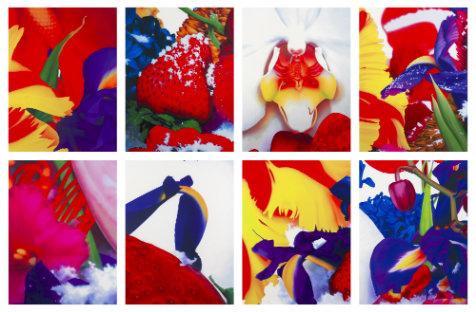There have been two previous ‘Artist’s Choice’ exhibitions at the Queensland Art Gallery in which an artist assembles a show from the Gallery’s collection. It’s an intriguing concept. The first, curated by Lawrence Daws was created around artists with whom Daws had an association or who influenced his work. The second, Buoyancy, by photographer Marian Drew, explored that very topical resource, water.
Michael Zavros’ approach is altogether different. Taking his own realist painting Unicorn in the anticamera 2008 as a starting point, Zavros has framed five contrasting interiors and illustrated each one with a spectrum of various media from the Gallery’s collection of paintings, furniture, sculpture, ceramics, photographs, prints, and rugs from Iran, West Turkestan and Russia.
These pieces and objects are thoughtfully and meticulously arranged and conjure wealth, decadence, status, cultural diversity and power. The chosen artefacts and their aesthetic arrangement within a space are stamped with Zavros’ preoccupations with glossy luxury items, fashion, taxidermy, horses, chairs and perfectionist craft. The choices made echo his own work.
In 2009, Zavros painted Narcissus, a self-portrait. In this, he stares at his reflection, not in water, but in the paintwork of his glimmering black Mercedes. In the 17th century, mirrors were extraordinarily expensive, the trappings of the super rich. In the ‘Hall of Mirrors’ Ian Burn’s glass mirror with adhesive lettering, ‘No object implies the existence of any other’ is ironic and cannily at odds with the spirit of an exhibition that rehearses multiples.
There are several still life paintings by Arthur Murch, Eric Wilson and Harley Griffiths in ‘Still Life Room’ and a collection of eight Painted Vases by Ai Weiwei (2005) and Covered Vases manufactured by WT Copeland & Sons Ltd (1875). In the same Interior are several pedestals including Tripod Art Nouveau pedestal and Square Pedestal, both hailing from the 1920s.
Are these rooms purely decorative? What happens to the meaning of De Kooning’s painting Two Trees on Mary Street … Amen in ‘Abstract Room’ when it is merely a splash of colors, a fancy backdrop serving a clutter of objects, albeit valuable ones, on a Ming Dynasty table? The work resides over an earthenware Horse from the Tang Dynasty, a Victorian Candelabra and a glass vase by Finnish designer Alvar Aalto.
Bridgit Riley’s Big Blue, inspired by the intense light and colours of Egypt, and De Kooning’s painting depend on the backdrop of a white wall to really sing. Incidentally, Riley was dismayed at seeing her original work ‘vulgarized in the rag trade’ when her designs blazed on dresses in 1965 without her permission. In this context, Riley and De Kooning’s works are muffled, harnessed to the dictates of trendy design, just as lifeless as the Hyena skin in ‘Chandelier Vestibule’ bearing the weight of a 19th Century porcelain table and Gemma Smith’s perspex Boulder Prototype.
Perhaps the most disconcerting is White Space with its grim trophy of a stuffed polar bear and Paola Pivi’s photograph of all white, stylized farm animals controlled, sanitized and shimmering with Piccinini’s white fiberglass sculpture Heaven Bound. The space prompts the viewer to wonder if the towering frozen bear resonating with Scott Redford’s My Beautiful Pink Polar Bears in ‘Abstract Room’ is political. Are these works drawing attention to the plight of yet another endangered species or are they but a shallow contemplation of this beleaguered creature as eye candy?
Arguably, the exhibition hints at contemporary concerns, Australia’s position within Asia, Australia’s colonial history, man’s misuse of resources, cultural diversity, gender and equality, art movements, what constitutes art and what is mere artefact. Yet, if Zavros’ exhibition is solely driven by the decorative dictates of interior design, it is all the more provocative because of it. The show offers a glimpse into an artist’s make up and examines historical trends. It probes our own collections of art and queries our relationship to them.
A Private Collection – Artist’s Choice: Michael Zavros
Queensland Art Gallery
23 March – 23 June





